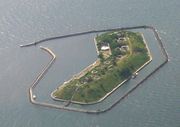Home > historical houses of europe > Flakfortet
Flakfortet, Denmark
|
Flakfortet, also known as Middelgrundsfortet or Middle Ground Fort, is an artificial island fortress located in the Øresund Strait near Copenhagen, Denmark. Built in the late 19th century, it was designed as part of Denmark's coastal defense system to protect the entrance to the harbor of Copenhagen and serve as a defensive stronghold against potential naval attacks. With its rich historical background, distinctive architecture, cultural significance, and ongoing preservation efforts, Flakfortet stands as a testament to Denmark's military history and architectural heritage.
|
The history of Flakfortet can be traced back to the late 19th century when tensions between Denmark and neighboring countries, particularly Germany, were high. Denmark recognized the need to bolster its coastal defenses to safeguard its sovereignty and strategically important locations. As a result, several fortified islands were constructed in the Øresund Strait, including Flakfortet. Construction of the fort began in 1890 and was completed in 1894.
The architecture and design of Flakfortet are impressive and reflect the principles of coastal fortification. The fort is situated on a hexagonal-shaped artificial island made of reinforced concrete and stone. Its layout includes a central courtyard surrounded by various buildings, such as gun emplacements, ammunition depots, barracks, and command posts. The design aimed to provide a strategic advantage, with a focus on structural strength and defensive capabilities. The fort was equipped with powerful artillery and defensive measures to repel potential attackers.
The cultural significance of Flakfortet lies in its historical importance and architectural value. It serves as a tangible reminder of Denmark's commitment to protecting its coastal areas and maritime interests. As one of the country's coastal defense installations, Flakfortet symbolizes Denmark's military heritage and the strategic challenges it faced in the past. Over the years, the fort has become an iconic landmark, attracting visitors who are interested in history, architecture, and military heritage.
Preservation and maintenance efforts have been instrumental in ensuring the longevity of Flakfortet. Given its historical significance, various measures have been taken to protect and restore the fort's original features. The fort has undergone renovations and restorations to maintain its architectural integrity, with a focus on preserving the unique elements of the structure and its historical character. Today, Flakfortet is managed by a private company that oversees its maintenance and visitor experiences.
For visitors, Flakfortet offers a unique opportunity to explore a historical military installation. Guided tours provide insights into the fort's history, architecture, and the role it played in Denmark's coastal defense system. Visitors can walk through the fort's corridors, visit the gun emplacements, and explore the different rooms and facilities that were once occupied by soldiers. Additionally, the fort's location in the Øresund Strait provides breathtaking views of the surrounding waters and the coastline.
In terms of tourism, Flakfortet has become a popular attraction for both locals and international visitors. Its historical significance, architectural beauty, and scenic location make it a compelling destination. The fort's management has also developed amenities and facilities to enhance the visitor experience, including a museum, a café, and exhibition spaces. These additions allow visitors to delve deeper into the fort's history and learn about its importance within the broader context of Danish coastal defense.
In conclusion, Flakfortet stands as a remarkable testament to Denmark's military history, architectural prowess, and cultural heritage. Its construction in the late 19th century as part of Denmark's coastal defense system underscores the strategic significance of the Øresund Strait. The fort's architecture and design reflect the principles of coastal fortification, with its hexagonal layout and defensive structures. Flakfortet's cultural significance lies in its role as a symbol of Denmark's military heritage and its ongoing preservation efforts. Today, visitors can experience the fort's historical ambiance, learn about its history, and appreciate its architectural beauty while enjoying panoramic views of the Øresund Strait. Flakfortet serves as a compelling destination for those interested in history, architecture, and military heritage.










